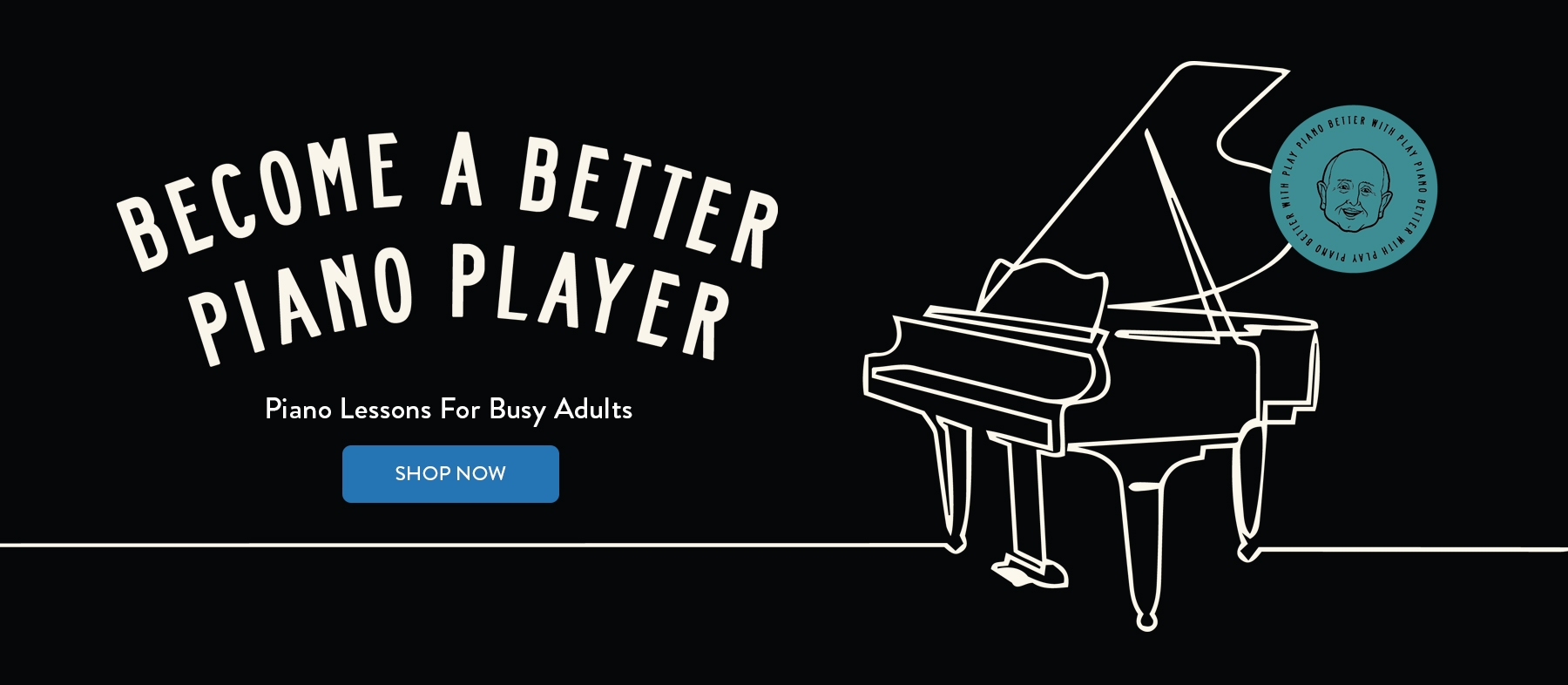Secrets of Exciting Chords & Chord Progressions: Lesson Thirty-Three
Chord Progressions Part 14:
“The ‘Alternating 7ths & m7th Chords’ Chord Progression”
Back a few lessons we learned about the circle of keys — also called the circle of 4ths, or the circle of 5ths.
Let’s take a review of that:
If you’ve ever heard of the “circle of 4ths” or the “circle of 5ths”, they are the same thing as the “circle of keys”. It just depends on whether you’re moving clockwise or counter-clockwise around the circle.
All the major keys that you can play in — 12 of ’em — are listed in this circle. Take a look for yourself:
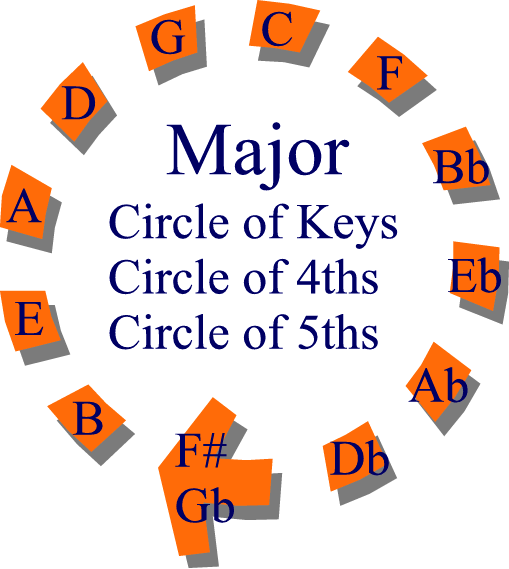
So “C” is at the top of your circle, and Gb (same as F#) is at the bottom of your circle.
Now memorize that circle. You’ll soon notice that each letter is a 4th above the previous letter — hence, the “circle of 4th”. Or if you go the other way, you’ll soon notice that each letter is a 5th above the previous letter — hence, the “circle of 5ths”.
This is the way chords “want” to move — up a 4th. Or up a 5th. You will find those to be the most common chord progression of all — up a 4th from the previous chord, or up a 5th from the previous chord.
For example, if the chord you are playing is C, the most likely chord to occur next is either F or G. You will notice that F comes directly to the right of C on the circle, and G directly to the left. (And you do remember, don’t you, that C, F, and G are the “family chords” of the Key of C? — the primary chords — therefore, the most likely chords to occur? — Now you know why!)
So that means that at any point on the circle you can immediately know the most likely chords — the chord to the left, and the chord to the right! Here’s a quiz:
What are the 3 most likely chords in the key of Db?
Right.
Db (of course), plus the chords on either side of it — Ab and Gb.
So what we come out with is this — the most likely chords in each key:
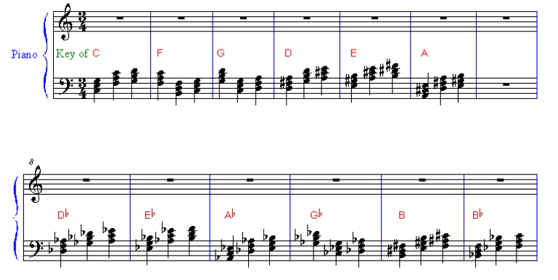
Do you see what an enormous advantage this gives you? You have a highly educated guess what chords are going to occur in the song you are playing based on the key that the song is written in. Not only that, you now know that chords like to either move up a 4th or a 5th (or down a 4th or 5th — same thing).
And so as we begin learning chord progressions, this is the first step — memorize the circle above until you can say it forward and backward and upside down and in your sleep! If I were you, I would print it out and stick it up on your piano or bathroom mirror or wherever you would see it often — it’s that important.
But there are also 12 minor keys in which songs can be written, so there must also be a circle of minor keys. It’s not as well known as the circle of major keys, but it works the same way. Here it is:
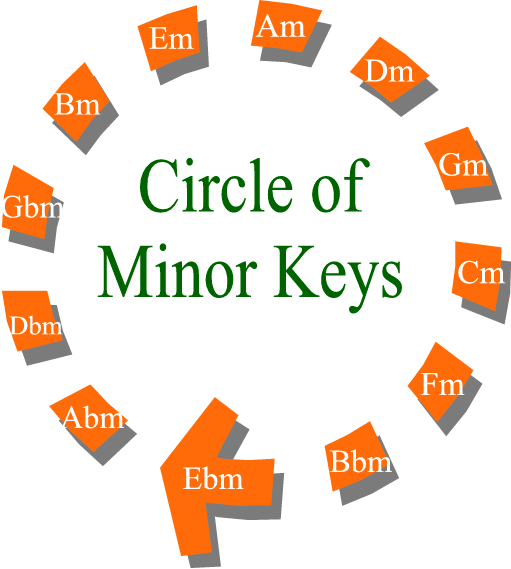
It works the same way as the major circle of keys, with one exception:
When figuring the 3 most likely chords in any key, you still look left and look right, but because of the fact that most songs written in the western hemisphere use the harmonic minor scale instead of the natural minor scale (which is much too involved to get into here — if you want to know about that in detail you’ll need to get a course on scales), the chord to the left is usually a MAJOR chord instead of a minor chord.
So in the key of Am, the 3 most likely chords would be Am, Dm, and E major — not E minor! There are some exceptions to that, but not many.
So what we come out with is this — the most likely chords in each minor key:

So — to repeat what I said:
Do you see what an enormous advantage this gives you? You have a highly educated guess what chords are going to occur in the song you are playing based on the key that the song is written in. Not only that, you now know that chords like to either move up a 4th or a 5th (or down a 4th or 5th — same thing).
Now what we are going to do is combine the two circles and add 7ths to each chord:
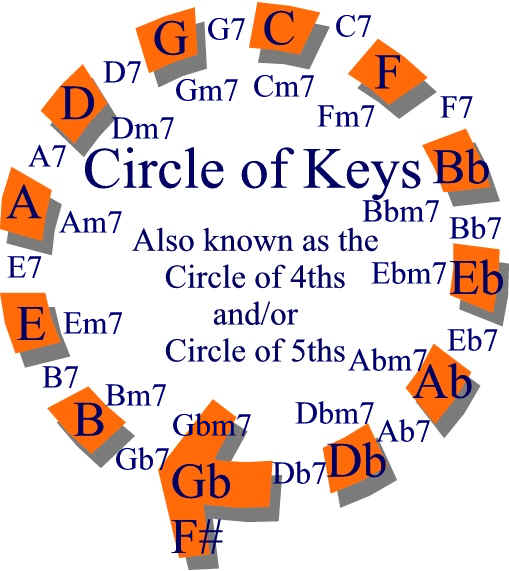
You’ll notice that between each of the 12 chords there is a 7th chord which connects one chord to the next chord as you move around the circle counter-clockwise. There is also a minor 7th chord which could be played as an alternative to the major chord.
Now — here’s the deal:
Thousands and thousands and thousands of songs have a section of this circle embedded in them! Not all the circle — just part of the circle.
For example, in the song ” All The Things You Are”, the right-hand part of the circle is being used from F to Db. Go to your piano and play these chords:
Fm7 Bbm7 Eb7 Ab Db
You will recognize those chords as the chord progression used in that particular song. The progression simply followed the circle around 5/12th of the way! If you knew about the circle of keys, that would be completely logical to you, and you would pick it up in a flash. If you didn’t know the circle, you might think they were just random chords!
Can you begin to see and understand why knowing chords and chord progressions is so critically important?
Then in the very next phrase of the same song the progression goes like this:
Cm7 Fm7 Bb7 Eb Ab
Hmmm. Does that ring a bell?
Sure. Another progression moving 5/12th of the way around the circle.
That’s how songs are made — combining one progression with another. Usually, though, songs only have 3 or 4 sets of progressions, and those progressions usually repeat within the song. So if you grasp the progression the first time it happens, you are looking for it to occur again, and you won’t be surprised when it happens.
Do you know the old song “Please don’t talk about me when I’m gone”? It uses this same progression. Here’s the theme:
Ab C7 F7 Bb7 Eb7 Ab
After starting on Ab, the composer jumps across the circle to C7, then predictably follows the circle 5/12ths of the way around the circle.
If you’re wondering if this only happens in popular music, get a copy of ” Liebestraum” by Lizst, and you’ll find exactly the same chord progression! In fact, you could play that section of Liebestraum at the same time you’re playing “Please don’t talk about me when I’m gone,” and the chords would match perfectly. (I’m not suggesting you do this except at home — taste is a different matter!)
We have a great course available that goes into all this in great depth — we’ve just scratched the surface here — so if you’re interested, be sure and take a look at Chords & Progressions & The Riffs & Runs That Flow Out Of Them.


